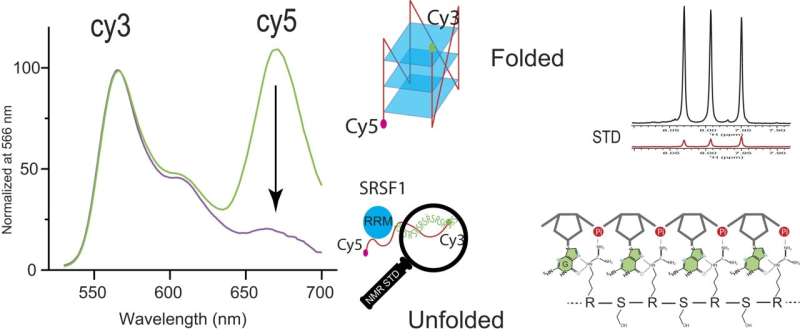This article has been reviewed according to Science X's editorial process and policies. Editors have highlighted the following attributes while ensuring the content's credibility:
fact-checked
peer-reviewed publication
trusted source
proofread
Researchers uncover protein SRSF1's uncommon ability to bind and unfold RNA G-quadruplexes

RNA transcription is the genomic process in which a cell produces a duplicate of a gene's DNA sequence. In a study published in Nucleic Acids Research, University of Alabama at Birmingham Department of Chemistry Professor Jun Zhang, Ph.D., and his team reveal how the protein SRSF1 possesses the novel function of binding and unfolding complex RNA Guanine-quadruplexes.
Present in both DNA and RNA sequences, a G-quadruplex (GQ) is a structure of four guanine bases attached in a planar array. These arrays, known as G-tetrad, are connected via Hoogsteen base pairings. It is commonly seen that three or more layers of G-tetrads are what make up a GQ structure.
In a normally functioning cell, most GQs are eventually unwound, so that the information encoded by the RNA can be used for protein expression. GQs are used commonly to regulate the protein expression level. However, due to the extreme stability of their structures, GQs are relatively difficult to unwind once formed in cells.
For example, if the GQ is not unwound, the ribosome cannot pass through, and the needed protein cannot be produced. This regulating function is important because, if the protein functions to suppress cancer cells, then an inability to unwind a GQ sequence can result in the replication of cancerous and malicious cells.
"This is important because understanding how we can easily open GQ structures could provide another avenue into the future of treatment options for certain illnesses," Zhang said. "There are previously no other external tools that we can easily use to open these structures in the cell."
Zhang and his team researched the Ser/Arg-rich, or SR, protein family.
There are 12 members of the SR protein family. This family of RNA-binding proteins is most known for RNA splicing. SRSF1 oversees the splicing of more than 1,500 different messenger RNA transcripts.
"The misfunction of splicing can result in the development of different illnesses such as cancer," Zhang said. "Around 60% of diseases can actually be attributed to the misfunction of splicing."
Each member of the SR protein family consists of one or two N-terminal RNA recognition motifs, or RRMs, and a phosphorylatable C-terminal protein region rich in repetitive Arg/Ser dipeptides, or RS.
Zhang's lab is the first to successfully solubilize full-length SRSF1 in its native state. Zhang's team used this to explore the RNA-binding landscape of SRSF1. In doing so successfully, Zhang's team found that SRSF1 RS prefers purine over pyrimidine.
In using the fluorescence resonance energy transfer, or FRET, between fluorescent chemicals Cy3 and Cy5, Zhang and his team were able to view the significant Cy5 signal decrease upon the adding of SRSF1. This decrease signifies a cooperative binding of SRSF1 to ARPC2 GQ and unfolding of the ARPC2 GQ.
"Our findings are just a beginning to understanding the broader roles SR proteins play in RNA splicing and translation," Zhang said. "Understanding these properties is important because it helps us to better understand how protein expression is regulated inside the cell."
More information: Naiduwadura Ivon Upekala De Silva et al, Unearthing a novel function of SRSF1 in binding and unfolding of RNA G-quadruplexes, Nucleic Acids Research (2024). DOI: 10.1093/nar/gkae213
Journal information: Nucleic Acids Research
Provided by University of Alabama at Birmingham





















